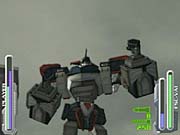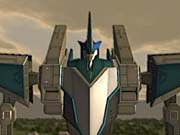Kitsch is king in Robot Alchemic Drive (RAD), the latest game from Japanese developer Sandlot. Mecha anime kitsch, to be specific, and no cliché is spared. Though the theme of the game will be familiar to mecha fans, the gameplay itself is fresh. And while the game is sometimes hampered by its nostalgia, it successfully and entertainingly captures the feel of controlling a giant robot like no other game has in the past.

As one of three characters in the role of the sole heir to the Tsukioka family legacy, you become the controller of one of three meganites, which are 40-meter-tall robots built by Tsukioka Industries and outfitted with an array of weaponry. The meganite is humanity's best hope against the volgara, a mysterious alien race that has invaded without warning, sending its own giant robots to lay waste to the Earth's cities. RAD's plot and dialogue will make you either giggle or groan, depending on whether or not you have a fondness for the simplistic plots and bad English dubbing of old anime shows or martial-arts movies. Not only is RAD's plot rather familiar and predictable, but the localization team, for effect, also purposefully mixed some nonactors in with some talented voice actors who were obviously directed to add extra ham.
The visual style of RAD's mechas matches its archetypal plot and dialogue, harkening back to the early Gundam and Macross styles, looks which distinguished themselves from their predecessors with a focus on believable articulation and a less rounded, more angular construction. A few modern touches are added, and the texturing is much more detailed than the flat coloring of the era, but the overall look has a great retro feel without seeming completely derivative. The weapons and moves of the meganites have appropriately melodramatic and wordy names like harken laser, gigantic booster, gravity zero, and grand charge crypt drill. The human character design and setting is distinctly from that era as well, though there are some things that don't quite fit in, like Abrams tanks and Apache helicopters.
While the art style of RAD is reminiscent of the styles used in the late '70s and early '80s, RAD's unique gameplay mechanic has its roots in the very first giant robot show, Tetsujin 28-go (known in America as Gigantor). Specifically, your meganite is remote-controlled, not piloted. In fact, part of the game involves finding a proper vantage point to control it from during missions. Thankfully, it's easy to do so, as the hero comes equipped with an antigravity belt that allows him or her to float up to rooftops. You can even get on the meganite itself using the belt. It's not a good place to be in a fight, but if the battle is on the other side of the city, it's good to be able to ride there quickly.
Once you hit the select button to take control of the meganite, the PS2 controller acts as the meganite's remote control, with the four shoulder buttons controlling the legs, the analog sticks controlling the arms, the directional pad controlling the torso, and the buttons controlling your beam and projectile weapons. Even the L3 and R3 buttons are used, each transforming one of the meganite's fists into an alternate weapon like a drill or a flamethrower. Most of the buzz surrounding RAD was centered on how complex this control scheme sounded, but the learning curve is actually very shallow. Your meganite won't fall over unless you jump into something or get knocked down by the enemy, so while you may flail around for a bit now and then, it's easy to recover and not frustrating. The game's two tutorial missions set you up for success very nicely, and RAD's designers struck a great balance between the complexity of the controls and the difficulty in using them. If you just can't get the hang of controlling the legs, you can take advantage of the game's easy mode, which lets you move the meganite with the directional pad.
RAD does a great job conveying the scale involved in the giant robot premise. No detail is overlooked in the techniques used. The most important and impressive of these is the engine's depth-of-field effect. The blurriness of a distant, towering volgara coming into focus as a news camera zooms in is superb, and the limits of human vision are accurately modeled with this effect as well. As for the mechas themselves, the animations for walking and winding up for punches and chops have a great look of inertia to them. Also, the bots have a great degree of surface detail even when viewed from up close. These touches, combined with an excellent positional sound engine that's matched perfectly to the controller's rumble effects, keep RAD from having the artificial feel that is often prevalent in other games that try to make the player feel exceptionally large or small.
Some portions of RAD, though, will pull you out of the game just as much as the aforementioned elements put you in it. There are a few minor annoyances, like the way buildings shatter into rather large triangles rather than collapse in a more realistic way, or the way the AI of the fleeing citizens makes them run into walls and push along their entire length when they're trying to go around a corner. The humans in general don't have the top-quality animation that the meganites do, exhibiting the familiar gliding effect that crops up when the gait of the animation doesn't match the rate of movement. There's also some frame rate chugging, though it's sporadic and is most prevalent in the scenes where there are a lot of bystanders, who either get away soon after the action starts or get squished fairly quickly.
The way the plot is executed is the biggest obstacle to getting into the game. There's always a lengthy setup for each mission, and it can't be skipped. You can fast-forward by holding down the start button, which cuts out the dialogue completely and speeds up any animation, but it's still a lengthy wait before the mission starts and you have to hold down the start button the entire time. Why you can fast-forward through the cutscenes but not skip them entirely is a little mystifying. Once the missions start getting more difficult, and you have to start redoing some, fast-forwarding becomes extremely annoying. The plot will also take control away from you during the missions themselves, usually so you can receive a message or watch a scripted event. There are some missions in which this happens annoyingly often. This also is a bizarre design decision, because there are plenty of times when a scripted event will take place and control isn't taken away.

The battles make it all worth it, though. Each of the three meganites has a great variety of moves, and they're all quite easy to remember and execute. More powerful weapons and armor can be unlocked with money earned from defeating each volgara and for keeping certain buildings from being destroyed. Sending a volgara flying through an entire city block with one hit or firing off salvos of missiles might look impressive, but it can cost you money. Yet it's still pretty easy to make enough to max out your favorite meganite, making this gameplay element just a bonus goal and a light diversion for in between missions. RAD has more than 50 missions, some of which are available only to certain meganites. There's even a sliver of a romantic element thrown in: There are a few possible relationships that can blossom in the plot's epilogue, all depending somewhat comically on how many times that girl's house or workplace gets knocked down during the game. One possible subplot even involves scoring points with a girl by making sure certain buildings get accidentally knocked down during the volgara attack. Along with a split-screen versus mode, these little additions give RAD a decent amount of replay value.
RAD is likely to appeal most to those who have a certain fondness for old pulp anime and find hokey dialogue and bad voice acting an easy pill to swallow when there are big robots and massive citywide devastation to go along with it. If that's you, then you should definitely give this unusual game a try.